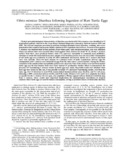| dc.creator | Campos, Elena | |
| dc.creator | Bolaños Acuña, Hilda | |
| dc.creator | Acuña, María Teresa | |
| dc.creator | Díaz, Gerardo | |
| dc.creator | Matamoros, María Cecilia | |
| dc.creator | Raventós Vorst, Henriette | |
| dc.creator | Sánchez, Luz Marina | |
| dc.creator | Sánchez, Olga | |
| dc.creator | Barquero, Candy | |
| dc.date.accessioned | 2014-05-26T16:08:14Z | |
| dc.date.available | 2014-05-26T16:08:14Z | |
| dc.date.issued | 1996-04 | |
| dc.identifier.citation | http://aem.asm.org/content/62/4/1141.full.pdf+html?sid=fd780aa8-5c92-4979-85b2-0fc8ed8a279e | |
| dc.identifier.issn | 1098-5336 | |
| dc.identifier.issn | 0099-2240 | |
| dc.identifier.uri | https://hdl.handle.net/10669/11066 | |
| dc.description | artículo (arbitrado) -- Universidad de Costa Rica. Centro de Investigaciones en Biología Celular y Molecular, 1996 | es |
| dc.description.abstract | Clinical and epidemiological characteristics of diarrhea associated with Vibrio mimicus were identified in 33 hospitalized patients referred to the Costa Rican National Diagnostic Laboratory Network between 1991 and 1994. The relevant symptoms presented by patients included abundant watery diarrhea, vomiting, and severe dehydration that required intravenous Dhaka solution in 83% of patients but not fever. Seroconversion against V. mimicus was demonstrated in four patients, from whom acute- and convalescent-phase sera were obtained. Those sera did not show cross-reaction when tested against Vibrio cholerae O1 strain VC-12. All the V. mimicus isolates from these cases produced cholera toxin (CT) and were susceptible to commonly used antibiotics. Attempts to isolate this bacterium from stool samples of 127 healthy persons were not successful. Consumption of raw turtle eggs was recalled by 11 of the 19 (58%) individuals interviewed. All but two V. mimicus diarrheal cases were sporadic. These two had a history of a common source of turtle (Lepidochelys olivacea) eggs for consumption, and V. mimicuswas isolated from eggs from the same source (a local market). Among the strains, variations in the antimicrobial susceptibility pattern were observed. None of the strains recovered from market turtle eggs nor the four isolates from river water showed CT production. Further efforts to demonstrate the presence of CT-producing V. mimicus strains in turtle eggs were made. Successful results were obtained when nest eggs were tested. In this case, it was possible to isolate CT- and non-CT-producing strains, even from the same egg. For CT detection we used PCR, enzyme-linked immunosorbent assay (ELISA), and Y-1 cell assay, obtaining a 100% correlation between ELISA and PCR results. Primers Col-1 and Col-2, originally described as specific for the V. cholerae O1 ctxA gene, also amplified a 302-bp segment with an identical restriction map from V. mimicus. These results have important implications for epidemiological surveillance in tropical countries where turtle eggs are used for human consumption, serving as potential sources of cholera-like diarrhea. | en |
| dc.description.sponsorship | Universidad de Costa Rica | es |
| dc.language.iso | en_US | es |
| dc.publisher | Applied and environmental microbiology, Apr. 1996, p. 1141–1144 | es |
| dc.relation | Applied and Environmental Microbiology, Apr. 1996, p. 1141–1144 | es |
| dc.subject | Vibrio mimicus | es |
| dc.subject | diarrhea | es |
| dc.subject | raw turtle eggs | es |
| dc.subject | Salud pública | es |
| dc.subject | Control de alimentos | es |
| dc.title | Vibrio mimicus diarrhea following ingestion of raw turtle eggs | es |
| dc.type | artículo original | |
| dc.description.procedence | UCR::Vicerrectoría de Investigación::Unidades de Investigación::Ciencias Básicas::Centro de Investigación en Biología Celular y Molecular (CIBCM) | es |


